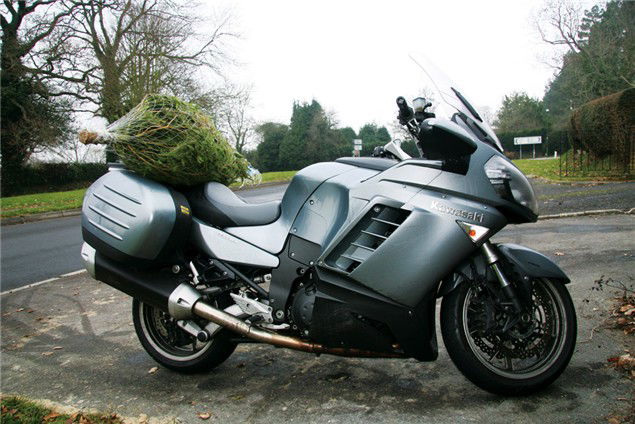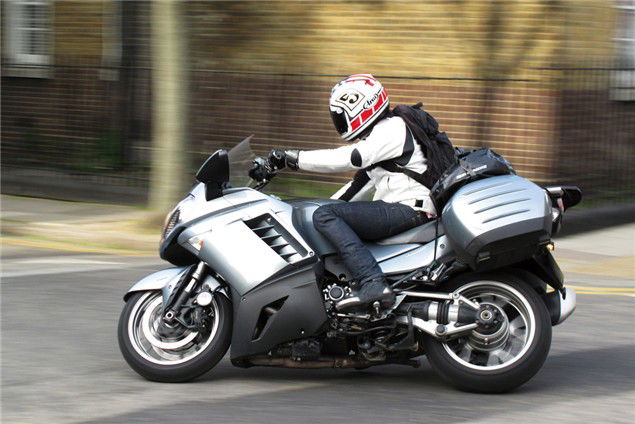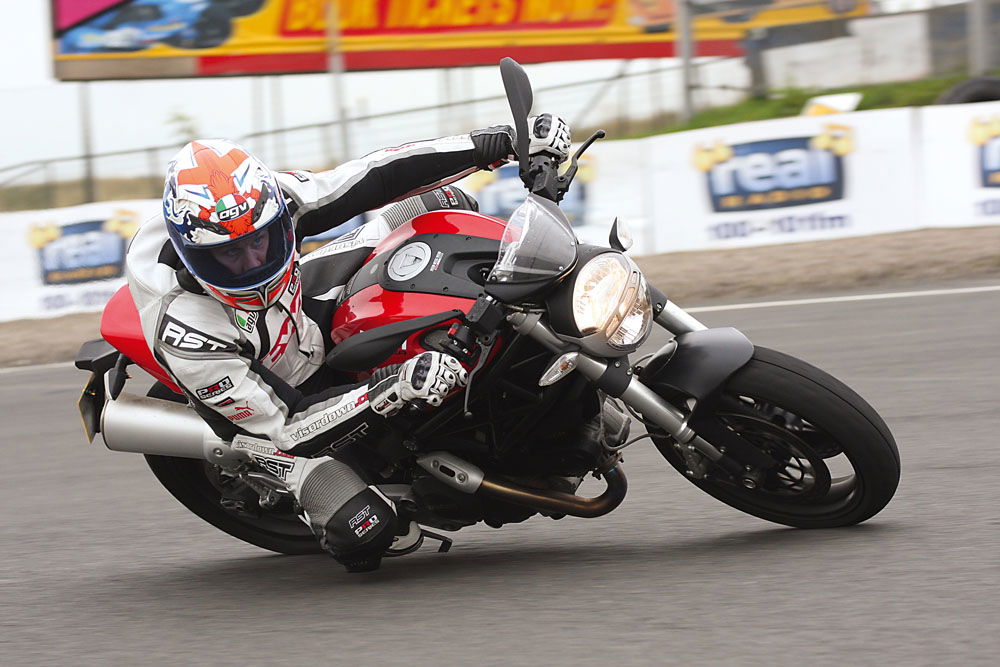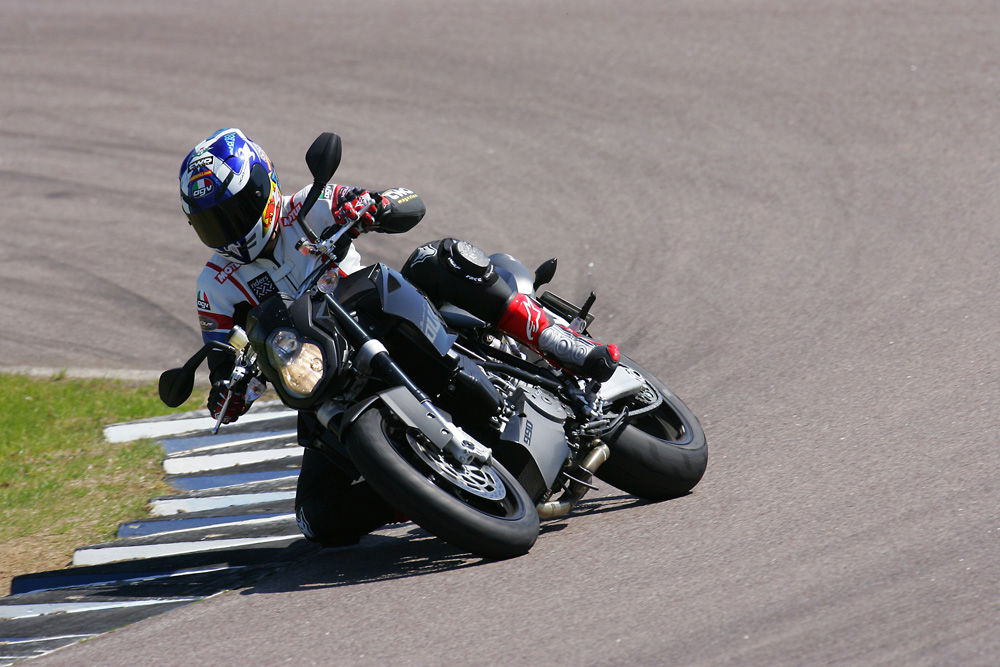Living with a 2009 Kawasaki GTR1400
Ben Miller sends some time with the GTR1400 and finds ten reasons to love and hate it

February 2009
This is the latest addition to the TWO longterm fleet, and the Kawasaki has come at a tough time! The worst winter in memory is battering us with sub-zero temperatures, and the roads are absolutely coated in salt and oxidising slime. Conditions have been truly treacherous, and the GTR1400 has been out in the thick of it all.
It’s a very handsome beast and extremely comfortable. The headlights are the most powerful I’ve ever ridden with at night, easily the same wattage as a big car and capable of illuminating the road for hundreds of yards. Unfortunately, the dip-switch is placed directly next to the switch for the electric screen, so in thick winter gloves you can be busily raising or lowering the screen while blinding everybody coming the other way. I’ve always been a fan of electric screens, they serve a purpose for when you want to cruise (fully up) and when you need to get somewhere in a hurry (fully down and crouch). The standard screen on the big Kawasaki is a little small for me – I’m 6’2” and could do with something a bit bigger for that gloriously silent, still-air scenario you get behind really vast touring screens. As it is I have to crouch slightly down to get that – I’m sure aftermarket companies will be churning these out. Although too big a screen looks immensely ugly.
The engine and handling are exceptional for a bike of this size and weight. Steering is predictable but certainly not slow, and the GTR can be hustled at a ridiculous rate if the mood takes you. There’s something deeply safe and unstoppable about it: the motorcycle equivalent of a BMW M5, if you will. The ZZR1400-sourced engine has the added benefit of Variable Valve Timing, giving the GTR a huge spread of power. Cruising at 90mph is ideal, but cruising at 140mph is equally simple. I found that the gearbox on this bike can get a little confused at times, especially when finding neutral at a standstill. It’s not something I remember from the launch last year, so maybe this one’s bedding-in. For some reason, heated handlebar grips aren’t an optional extra from Kawasaki. They’re missing a huge trick here, as potential owners of this bike would be queuing up to have them fitted. I’m 38 years old now and simply can’t imagine riding a bike in winter without them.
The pannier system is excellent for a Japanese tourer, simple to use without bending the key every time you want to open or close them and with plenty of volume for helmets, clothes and shopping. Using the topbox as well I can get a whole week’s food shopping in there (I eat mostly 1kg slabs of Tesco Finest pre-made lasagne, Basmati rice, potatoes, chicken and broccoli by the half-ton). The only thing I’m not totally convinced about is the frightfully clever KIPASS electronic key fob. You don’t have a conventional key, just a box of tricks that allows the bike to be started miles: 6,242
final tally when you’re within sitting distance. If you set the steering lock and walk away, it stays locked. It’s very clever – but when it comes to using the panniers or filling up with gas, it’s a right fiddle. You either use the key system in the ignition, in which case you then have to put it back, or have to dig out a spare key using a tiny button on the KIPASS box, which is tricky at the best of times. When your hands are frozen cold, it’s pitch dark and your other hand is carrying stuff, it makes you growl with impatience.
The GTR is lovely and luxurious. Here’s to many happy months.
Final Tally
- Modifications: top-box kit
- Costs so far: £22 of gas every 180 miles
Miles: 6,242
May 2009
Seven am on a bright and almost summer March morning and I’ve got two hours to get to the office in Islington, central London. The last of the week’s stuff goes into and onto the long-term GTR and we hit the A1 south. Hardly the world’s most efficient motorway – too many snarl-ups, too many 50mph zones – but at least stuff happens. Just when you can’t take any more multi-lane monotony, along comes a roundabout to absolutely monster. The GTR happily obliges. Billed as a sports-tourer, on weight and girth alone the Kawasaki feels full tourer to me, albeit more FJR1300 than Pan European. The brakes are strong (radial four-piston front calipers, linked and ABS equipped), the chassis’ poise under heavy deceleration admirable and the bike’s sheer power lovable – ZZR1400-based but with added variable valve timing it’s huge, propelling the GTR back up to speed with effortlessness that makes the thing feel weightless.
All’s well then, at least if you’re on fresh tyres. There I was, all set to deliver a damning verdict on how heavy and uncertain the GTR’s steering is, certainly for a bike billed as a very sporty tourer, when a casual inspection of its Bridgestone tyres revealed they’re horrifically squared-off. As if suddenly aware their game was up, the front then developed a slow puncture. Handy then that the Kawasaki’s onboard tyre pressure monitors displayed a steady 38psi – peace of mind when you’re cruising at GTR speeds.
So the handling verdict must wait, but ridden like a tourer, with a smug silkiness, the GTR feels superb. The power’s always there, the stability absolute, even in crosswinds, the ride quality fine and the comfort, from the superb seat to the electrically adjustable screen (if only it was taller, as with every other bike on sale) welcome on what will be a regular distance-commuter.
In an hour the A1’s dispatched and I hit London, at which point the GTR immediately feels like trying to fly the Grand Canyon in a B52. The low-speed balance is excellent, and most gaps are possible with the mirrors folded back, but the GTR belongs on the open road. Europe with a month to kill? I’d love to. But that’s for a mid-summer month when the sun is shining...
DATE RECEIVED: 18th Dec 2008
TEST DURATION: 10 months
TOTAL MILEAGE: 4630 miles
MILEAGE THIS MONTH: 1112 miles
COSTS THIS MONTH: £0
PURCHASE PRICE: £10,968
July 2009
Last time I wrote about the GTR, the problem was rubber. Impressed with the bike’s power and comfort, I held back from passing judgement on its handling since the tyres were square toast. Our test bike arrived on OE Bridgestone BT-021s, badged E to indicate they had met with Kawasaki’s approval. When I took custody of the bike at the 6000-mile mark, these were badly squared off and had, quite predictably, left the steering feeling horrible. 6000 miles doesn’t seem too bad for such a heavy, powerful bike, but some owners report killing a pair in 2500 – really?
This month another pair of BT-021s (not E-specs but standard BT-021, which vary very slightly in construction) from the kind souls at Bridgestone UK were fitted. The Kawasaki’s been transformed. With an unbroken radius to roll around, the GTR’s heavyweight turn-in has disappeared, replaced with an agility and readiness to turn at odds with the bike’s sheer size. Overall the handling is tidy, with accurate steering and a chassis that reassures when you lean; even in the wet, the combination of the Bridgestones tyres’ generous grip and the chassis’ fear-free composure means you’re happy to press-on.
Recommended pressures are a lofty 42psi at both ends. “As a rule of thumb, most 600cc+ machines use pressures of around 36/42 but, on a heavy, powerful bike like the GTR, the higher pressure in the front helps the tyre retain its intended profile and give a positive, neutral feel,” explains Bridgestone UK’s Gary Hartshorne. “With lower pressures you’d get tyre walk and a soggy, squishy feel from the front end.” Some owners have experimented with other makes of rubber, and I’ll be looking to try Dunlop’s Roadsmart next.
While too many of my miles are on motorways and London’s traffic-choked boulevards, through which the Kawasaki is surprisingly good thanks to its awesome lowspeed balance, a couple of spins up favourite back roads have proved entertaining now that the bike wants to turn, though over lumps and bumps the suspension’s composure isn’t rock solid. The oil and the valves try valiantly but largely fail to damp the movement of all that weight on its springs. While both ends are fully adjustable, I’ve resisted the urge to get busy with the twiddlers – the bike’s misbehaviour is completely benign and just helps remind you it takes a calmer hand to get the best from the Kawasaki.
Following the advice of ultra-quick cop trainer Andy Morrison does the trick. As he explained in the “How to ride any kind of bike” feature in the May issue, speed on any bike is about working to its strengths. In the case of the GTR they are its ability to speed up and slow down very, very quickly. So you brake late and hard, keep your corner speeds conservative, particularly if there are visible bumps involved, and get back on the power just as soon as you fancy. Ridden thus, few roads stand a chance.
DATE RECEIVED: 18th December 2008
PARTS ADDED: None
TOTAL MILEAGE: 9815 miles
MILEAGE THIS MONTH: 2463 miles
COSTS THIS MONTH: Bridgestone BT021s, fitted £260
PURCHASE PRICE: £10,968
October 2009
With over 13,000 miles now on the GTR’s odometer, it’s the little things that are making a big difference. After all, the 1400 is a bike designed to do big miles
The good...
01 STONKING BRAKES
Hardly detail, but the Kawasaki’s front brake set-up is awesome nonetheless. And when you’ve got an engine as relentlessly giving as the GTR’s, not to mention an all-up fighting weight on the generous side of average, that’s a good thing. The radially-mounted, four-piston front calipers have power and feel to spare; an all too rare blend on tourers. The forks have the composure to let you use that power, too. And should you get carried away, the ABS will save your bacon. I’ve triggered the system perhaps three times so far in normal use, braking hard downhill on the bumpy approach to the same roundabout. Needless to say, the momentary loss of braking power is terrifying the first time it happens.
02 SUPER-SWEET SEAT
While designing a seat that looks comfortable is pretty straightforward, putting one into production that actually proves it over thousands of miles is altogether trickier. The GTR’s manages the not inconsiderable feat of being both initially plush and comfortable on the long haul. My backside loves the thing; no numbing, no pins and needles and no fidgeting. Does a sterling job of keeping you on the bike when you give the thing full beans, too.
03 LOADS OF BUNGEE POINTS
With a full complement of hard luggage, bungee points shouldn’t matter but, given an inter-London commute that rules out using the panniers on the grounds of excessive width, and a topbox that remains in the editor’s garage despite countless requests, I’m using soft luggage, a huge Hein Gericke travel sausage. Securing it, together with spare kit, waterproofs and additional bags, is easy on the GTR’s broad passenger seat and rack; take your pick from a plethora of potential bungee points. Pillions rate the back seat, too.
04 TANK-TOP CUBBYHOLE
Like a glovebox, only on your bike. Big enough for house keys, spare earplugs, your wallet and directions printouts for places you went to months ago, this compartment’s really handy. It can’t be locked but then, when you keep the bike’s remote keyfob in there like I do, that’s probably a good thing.
05 EASY-FOLD MIRRORS
Easily tucked in on the move, folding the GTR’s brilliant mirrors back buys you an additional 6 inches of narrowness. On the A40 in rush hour, that’s the difference between life and, well, being late, angry and humiliated.
06 TYRE PRESSURE MONITORS
Still rare on motorcycles, the GTR’s onboard computer display can show tyre pressures front and rear – a great feature for worriers like myself. Plus you can watch the pressures rise a couple of pounds per squareinch over the first few miles, which is a fair indication you’ve warmed the rubber enough to get stuck in. Really came into their own when I had a slow puncture in the front tyre.
...and the not so good
07 FINISH ON THE FRAME
Bizarrely this area of the frame, just above the left footpeg, has lost all the paint from its outer faces, no doubt the result of wear from my boots. Why this should be when I use relatively hard-armour-free Dainese boots is beyond me. The wear is restricted to the left side too, I guess where frantic gear shifting creates more foot movement. Disappointing – perhaps Kawasaki will bring out a suitably tough hard part to sort the problem?
08 FINAL DRIVE JERKINESS
After more than 6000 miles my biggest gripe with the GTR – and it’s really not all that big – is the sometimes very clunky transition from a trailing throttle to a positive one. Part of the problem’s undoubtedly my brutish throttle control, but the combination of fairly abrupt fuelling and a clunky final drive can become annoying. By contrast the BMW K1300GT I rode recently was a much more refined beast, a product no doubt of BMW’s huge experience with shaft final drives.
09 FUEL RANGE
In mixed use – a combination of fast motorway riding and very, very slow traffic-busting – the GTR usually flashes a fuel warning at around the 180-mile mark, though necessity has pushed me to around 210 miles once or twice. While this is the going rate these days, the seat is so good it’s often a shame to have to stop merely for unleaded. An inch more height on the tank wouldn’t offend anyone and could take the range out to 250+ miles.
10 OLD-SCHOOL SUSPENSION ADJUSTMENT
While the Kawasaki boasts adjustment at both ends (rear preload is particularly easy thanks to the remote knob), the ESA II system on the BMW K1300GT is a genuinely useful innovation, letting you adjust the chassis to your mood or requirements in seconds. Quite apart from the adjustment, the GTR could use some of the BMW’s damping control too, the German being more composed hitting midcorner bumps. Whether the BMW’s control will be so sweet after 13,000 miles is less certain.




